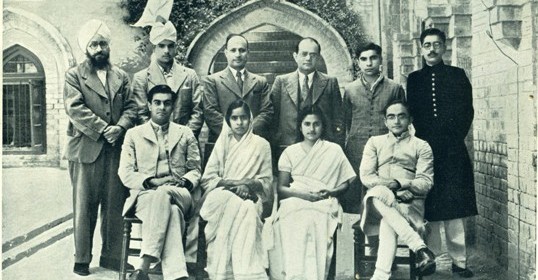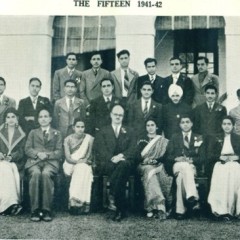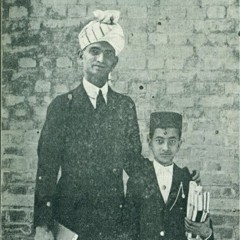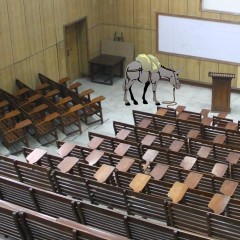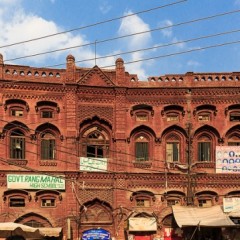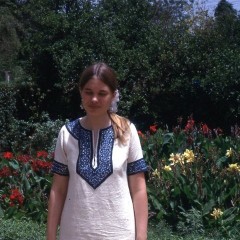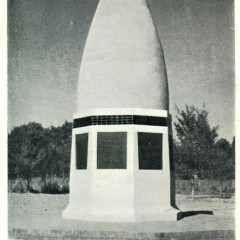Founding of “The Fifteen”
Mowbray Velte first came to this country when he was hardly one year old in 1894, and then as a short termer in 1915, the youngest and handsomest member of the Forman Christian Staff, hardly distinguishable in age, appearance and temperament and activities from his pupils with whom he mixed so freely. During his brief stay of three or four years he founded the famous ‘Fifteen’ the premier literary society of the college and the province. Among the first members of the ‘Fifteen’ were distinguished gentlemen like Shi Gulzari Nanda, Mr D. K. Sen both of them holding supreme positions in India as senior member of Pandit Jawahar Lal Nehru’s cabinet and Prime Minister of Patiala respectively, Principal Khanna, A. N. Das Gupta, C. L. Aggarwal and myself and the deceased Mr Mohammad Aslam, Income-Tax Commissioner and S. Kartar Singh Advocate. The ‘Fifteen’ founded in 1916-1917 has continued now for more than forty-five years. The idea behind the founding of the ‘Fifteen’ was the revival of the traditions and achievements of the Literary Club, founded by Dr. Johnson during the eighteenth century of which he was the Founder-Dictator and Garrick, Sir Joshua Reynolds, Goldsmith Boswell and Edmund Burke were the distinguished members. The ‘Fifteen’ has produced quite a galaxy of eminent scholars, statesmen, poets and men of letters. Dr Velte had something of the great Dr Johnson about him. His charming personality, his love of the best that has been thought and written and his first hand knowledge of the latest and most ancient classics in art and literature. The members of the ‘Fifteen’ were equally at home in classical literature as well as the Roman and the great apostles and pioneers of modern literature. We liberally surveyed the extensive domains of literature from China to Peru, that is, from Geoffrey Chaucer to Oscar Wilde and from Oscar Wilde to Pearl Buck. Leonard Da Vinchi, Rembrandt, Goethe, Tolstoi, Tagore and Iqbal were exhaustively discussed and criticized at these meetings. Dr Velte was the soul of the whole assembly that met each fortnight and Mrs Velte our chief hostess and patron. None who has been a ‘Fifteener’ can forget those meetings and fruitful and creative discussions. Some of the most distinguished members of the Bar, the Bench, the Civil Services and even those who are in the cabinet on both sides enjoyed this rare privilege and are really proud of it. Mr Mumtaz Hasan, Finance Secretary, Mr Wazir Ali another Finance Secretary; Mr Ata Ullah Kalim, Chief Controller, Military Accountant, Principal M. M. Anwar and great many of the younger and older members of the Pakistan Civil Service and...
The Long and Short of It
In an irreverent 1917 publication by students of FCC, the photograph (and title) above had the following caption: “On the right a student of the First Year Class; on the left a student of the Sixth Year (M.A.) Class. The contrast illustrates the remarkable physical development which accompanies the mental culture which F. C. C. gives her students.” Image and text: Pictorial Number of the Forman Christian College Monthly, August, 1917. Published by Rev R L Wilson, Forman Christian College, Lahore. Printed by Edwin Haward at The Civil and Military Gazette Press. While the photographer has not been named for this photograph, the final page of the publication states: “The Editors gratefully acknowledge their obligation to Mr. Ferger for the majority of the pictures herein...
A Donkey in the Class
by Alfred Sohan Lall Dr Thoburn used to take a large general Physics class in P-10, maybe three or four sections together. This is the large auditorium on the ground floor of P Block and it has a door leading directly outdoors at one end of the room. During those days there was construction going on in the campus and donkeys were used to bring bricks and gravel and other material. One day a donkey wandered over towards P-10, probably because it felt the cool breeze coming from inside. The students opened the door, brought the donkey in and tethered it to the front of the class. When Dr Thoburn came in, he completely ignored the donkey and proceeded to take attendance. When all the students had been accounted for, he pointed towards the donkey and asked them, “What is the name of this student?” The students felt so embarrassed, that two of them quietly got up and led the donkey out of the auditorium. This story was told to me by Dr Thoburn himself. He was the head of the Physics Department when I joined FC in 1961. Image of donkey is in public domain. Photograph of P-10 in FCC...
Historical Sketch
The Forman Christian College is an aided institution, preparing students for degrees in Arts and Sciences of the Punjab University. It is under the care of, and supported by, the Ludhiana Mission, of the American Presbyterian Church, United States of America, and is controlled by a Board of Trustees appointed by that Mission. It was formerly called the Lahore Mission College, but in November, 1894, by an action of the Ludhiana Mission this name was changed to that of “The Forman Christian College”. Dr. Forman’s actual connection with the College covers a period of only a few years, yet his work was the necessary preparation for the enterprise and forms the foundation on which it will ever rest. Any sketch of the history of the Forman Christian College would be incomplete without a reference to the older institution, the Mission School, out of which it grew, and with which its early history is interwoven. First Beginnings. On December 19th, 1849, the Rev. C. W. Forman, D. D., opened a small School near the Bhati Gate. It was the first A. V. [Anglo Vernacular i.e. English medium] institution in Lahore, and indeed the first North of the Beas. It began with only three boys, for there was little desire for education among Panjabis in those days, and the first pupils had to be paid to induce them to come to school. But the people soon began to see where their interests lay, and under Dr. Forman’s wise and able management the school rapidly grew, until after a period of 20 years there were some 1,600 pupils reading in the Rang Mahal and in Branches connected with it. It was now felt by Dr. Forman that the time had come for completing his educational system by the establishment of a College Department. Accordingly, Collegiate classes were opened by him in 1864, and, on his departure to America, the Rev. Alexander Henry, M. A. became the Principal of the new institution, while the Rev. W. J. P. Morrison occupied the chair of English Language and Literature. The College enjoyed a brief but prosperous existence. Within the four years that it remained in operation it was successful in passing the following Graduates and Under-Graduates at the Calcutta University Examinations:- GRADUATES. G. S. Lewis, Esq., Extra Judicial Assistant Commissioner, Amballa. Lala Thakur Das, Assistant Inspector of Schools, Rawalpindi. (Died 1890.) UNDER-GRADUATES. — (F. A.) Jacob Basten, Esq., Head Master, M. B. School, Jullunder. Pandit Prem Nath, Examiner of Accounts, P. W. D., Punjab. Lala Sulakhan Mall, Accountant, P. W. Department. Lala Dina Nath, Munsiff, Jullunder District. In 1868, owing to Mr. Henry’s sudden...
The Good Old Days
By Anne Tebbe Kidd By the time my father, Dr Robert Tebbe, accepted an appointment to serve as principal at FC College, my three older brothers had already returned to the US. Instead of a family with five children, my parents moved to Lahore with their two daughters, Anne and Margaret. For me, the move opened up a whole new set of experiences in Pakistan. During the years my father worked at Gordon College in the heart of the bustling city of Rawalpindi, my sister and I had been mostly restricted to our residential compound. Although leaving our friends in Rawalpindi was hard, coming to the spacious peace of FCC campus gave my sister and me freedoms we had never before known in Pakistan. It was a time of building new relationships and having different experiences … like swimming in the campus pool, albeit a pool in desperate need of clean water; biking and walking through the residential parts of the campus without chaperones; and going to movies or bazaars with a new friend (the wife of a junior professor). My mother, a highly social person, had an insatiable interest in knowing and being a friend to all. One memory I have of our time at FCC is the several days of tea parties over the Christmas season that enabled our family to invite all faculty members and their spouses in for a few hours. My mother saw the faculty families as her extended family so she wanted to be sure she had a chance to share a bit of holiday cheer. My sister and I were pressed into service for these teas, which may be why they stand out in my memory. My mother managed the guest list to be sure the faculty whose wives observed purdah could attend by dividing the list so the number of wives in purdah attending each of the days could be accommodated in the study. What has stayed with me since I left Pakistan so many years ago is the feeling of goodwill and community among the staff and families at FCC. I loved our life there. Last month the Tebbe children moved my 92-year old mother who now lives in Lakeland, Florida, USA, from her house to a more convenient apartment. One of my brothers claimed the big tea tray she had kept since her FC College days. It was the tray she said she used to serve “hundreds of cups of tea.” Though hundreds of cups of tea may have been served from her tray, all of us shared memories of the thousands of cups of tea we enjoyed with others...
Unveiling of Memorial Pillar at New Site 1936
After luncheon at the new site [the current campus], on December the 20th, 1936, Dr. S. K. Dutta conducted the gathering to the Memorial Pillar, where it stood like a gigantic finger pointing to the heaven, a silent testimony to the selfless work of Dr. C. W. Forman, the Founder of this College, and his successors. The Principal guided the company and, stopping at each tablet, read out its contents. On the first tablet was a history of the College and the date of its foundation and of the erection of the Pillar. The next tablet contained a list of five names – mere names and no more. But names that mean much to every Formanite – Dr. C. W. Forman, the Founder of this College, Dr. H.C. Velte, Sir James Ewing, Dr H.D. Griswold, Dr. J. H. Orbison, all of whom occupy a definite niche in the fifty years of existence of the Forman Christian College. The third tablet again contained names and no more. But each of these names signifies the progressive evolution of this College, as it advanced step by step, from a College with fifteen students to a College now containing over one thousand students. Forman, Ewing, Lucas, Dutta – all stepping-stones in the progress of the College; significant of what the College was and what it will be. With the erection of this Memorial Pillar we ring down the curtain over the fifty years of service of this College. M. C. Sanyal (Assistant Editor, The Folio, FCC Magazine, 1936-37) Source of text and image: The Folio, FCC Magazine, Vol. XXVIII, January 1937 to February 1937. Notes: Dr Sufian Aslam (FCC 1968-1972), Dean of Sciences, remembers seeing this monument when he was a student at FCC. It was on the land which currently has the PCSIR buildings. The monument was pulled down when the boundary wall was...


